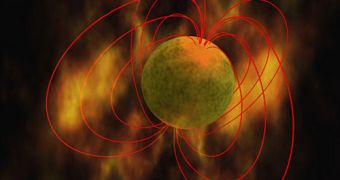In a new series of studies, astrophysicists managed to determine what is left behind after the collapse of massive stars, which release most of their energy as gamma-ray bursts. GRB are the most violent explosions in the Universe, and apparently they can produce certain kinds of neutron stars.
According to investigations of these leftovers, the most common consequences of GRB explosions are the appearance of black hole-like “graveyards” in space, as well as a special type of fast-spinning neutron star, called a magnetar.
The blasts take place when very massive stars, hundreds to thousands of times heavier than our Sun, exhaust their hydrogen gas supplies, and have insufficient fuel to conduct nuclear fusion. The reaction therefore grinds to a halt.
As this happens, the force that was pushing outward from the core of the star disappears too, and gravity begins to take over. Once a certain threshold is reached, the star collapses on its own core in a massive explosion.
This type of event is sometimes known as a supernova, and it produces intense GRB, depending on how large the star that blew up was. Not all GRB originate in supernovae, however.
In one of the new studies, it was demonstrated that only a star collapsing into a black hole can produce the most intense GRB that were observed until now, Space reports.
“We have focused only on the brightest and most extreme GRB, arguing that the energy release from these events is too large to be powered by collapse to a neutron star (magnetar),” explains expert Brad Cenko.
He is a research scientist with the team that made the discovery, and holds an appointment as a post-doctoral fellow at the University of California in Berkeley (UCB).
The science group determined that some of the GRB observed by spacecraft such as the NASA Fermi Gamma-ray Telescope can be produced by magnetars. These neutron stars are extremely dense, spin very fast, and produce massive magnetic fields.
One interesting thing about them is that their incredible densities force the positively-charged protons and negatively-charged electrons making them up to fuse together, forming neutrons – hence the name.
The second study found that massive stars which produce GRB when they die can collapse into magnetars rather than black holes. The scientists behind it say that the two investigations do not conflict with each other in any way.
“Our results are certainly not mutually exclusive – we both are looking at relatively small sub-samples of GRB,” Cenko explains.
“I think what our work shows is that magnetars are a viable model. For this feature that we see, it's very hard to see how you could do it for a black hole. It's much more consistent with a magnetar model,” adds scientist Paul O'Brien.
The expert is based at the University of Leicester, in the United Kingdom, and he was a member of the research team that conducted the second study.
The difference between magnetars and black holes is their respective limits in terms of mass. When stars collapse into magnetars, the resulting bodies can only grow until they reach a certain threshold.
Once that limit is reached, the gravity of the body becomes too intense, and it too collapses into a black hole. But the holes have no mass limit, and they can grow to massive sizes.
Until now, astrophysicists did not believe that magnetars had sufficient mass to produce GRB, but the new investigations showed that at least some of these neutron stars are.

 14 DAY TRIAL //
14 DAY TRIAL //